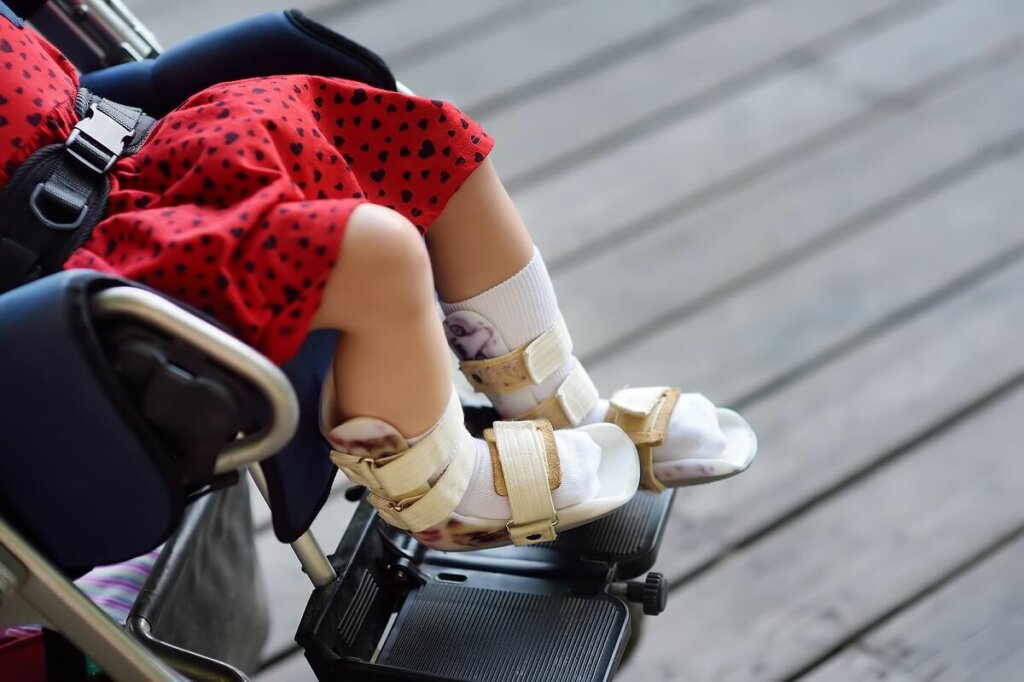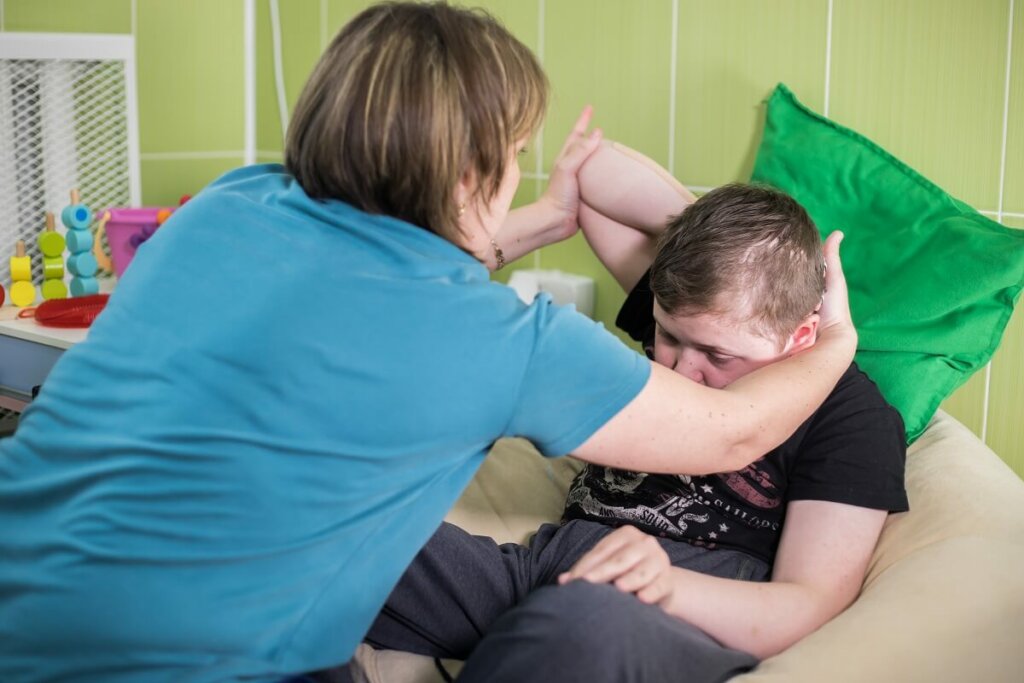What Are the Types of Cerebral Palsy?


Written and verified by the doctor Leonardo Biolatto
The different types of cerebral palsy that exist have different medical classifications that aid their management and diagnosis. However, each case is a serious condition in its own right, especially when present in children.
In medical terms, cerebral palsy refers to a group of disorders that affect muscular mobility, and which are caused by damage in the individual’s brain. Additionally, the condition can extend to other parts of the nervous system, as well as other variables.
In this article, we’ll discuss the different types of this disorder in order to understand it better. One type of this disorder is categorized by how affected the individual’s posture is, whilst others are determined by the part of the body they affect. They can also be rated by their severity.
Classification by muscle tone and posture
In this category of cerebral palsy, most commonly the individual’s posture varies. This is directly related to their muscle tone, and can cause spasms, involuntary movements, or ataxia.

Cerebral palsy occurs due to localized damage in the brain, which affects muscular movement.
Spastic cerebral palsy
This is the most common type of cerebral palsy. The muscles in people affected by this type are in an exaggerated state of tension and their reflexes are weak. People with spastic cerebral palsy can’t walk properly. They’re only able to drag their lower limbs due a loss of joint mobility.
Those affected tend to move in a scissor style. Here, the weaker limb crosses behind the other without bending at the knee. This type also leads to loss of muscle mass as those affected tend to have more shrunken muscle fibers.
Keep reading: 6 Interesting Facts About the Brain
Hypnotic cerebral palsy
Contrary to what we described in the previous section, people with this kind of cerebral palsy have very little muscle mass. Their muscles don’t stay contracted and the person is unable to stay upright with their limbs relaxed, and they have no strength.
The biggest risk for those with this type of cerebral palsy is how it affects their respiratory system; both the children and adults affected have difficulties with how their chests work.
Athetoid cerebral palsy
This type of cerebral palsy causes chaotic movement in the entire body. The muscles involuntarily contract and relax in both the superior and inferior limbs.
In regards to the face, this type of cerebral palsy tends to be located in the tongue, and as such, facial expressions tend to change abruptly when a spasm arises.
Ataxic cerebral palsy
Ataxic cerebral palsy is similar to the athetoid variation, but is far less common; the latter is more stereotypical. The movements here also appear involuntarily and at random. Those affected struggle with their balance, both when sitting and standing.
Mixed cerebral palsy
Mixed cerebral palsy is no more than a combination of the aforementioned symptoms. Diagnosis is difficult, though, since the medical specialists that encounter this problem aren’t always sure which diagnosis best fits the patient.
Types of cerebral palsy determined by the affected body part
The type of cerebral palsy and its classification depends on which part of the body it affects or presents the most symptoms. The different classifications are:
- Hemiplegia: this applies to cases where only one side of the body, right or left, has symptoms. This reflects which region of the brain has been affected.
- Paraplegia: for cases where the lower half of the body, from the waist down, presents symptoms. People with this classification are paraplegic.
- Tetraplegia: these are the cases in which almost the entire body is affected; all four limbs, or from the neck down.
- Diplegia: this particular type of cerebral palsy most frequently occurs in children. In adults it’s less frequent. The symptoms are localized to the inferior limbs and are accompanied by muscular spasms.
- Monoplegia: monoplegia is focused on one specific limb or muscular region, and doesn’t affect any other part of the body; not the rest of the same side nor the other. It can also be located in a specific muscular area.

Cerebral palsy can also be classified by the part of the body it affects.
Classification by severity
This method of classifying cerebral palsy is based on an international consensus, as presented in the Gross Motor Function Classification System (GMFCS). This is as agreed between the World Health Organisation (WHO) and the Surveillance of Cerebral Palsy in Europe (SCPE).
Based on the criteria determined by the consensus, we can discuss the following types:
- Mild: in these cases the individual affected can walk, but with certain limitations. They’re able to move around without relying on the support of external devices like a crutch or a wheelchair.
- Moderate: those with a moderate form of cerebral palsy will need the help of a third-party in order to stand up and sit down. They almost always use wheelchairs, although they can manage these independently, especially indoors.
- Severe: the most severe form of cerebral palsy is where the individual is unable to support their head themselves, and, as such, requires constant assistance for help with every daily task.
Discover more: Cerebral Hypoxia: Types and Causes
What’s the “best” type?
There aren’t any types of cerebral palsy that are ‘better’ than the others. Therefore, each kind meets a specific criteria. In some cases, cerebral palsy responds better to rehabilitation therapies, whereas others require a more medical approach.
An accurate diagnosis is essential, as it helps specialists to develop a detailed rehabilitation plan to improve the quality of life through physiotherapy, psychosocial support, support networks, and also medical treatment.
All cited sources were thoroughly reviewed by our team to ensure their quality, reliability, currency, and validity. The bibliography of this article was considered reliable and of academic or scientific accuracy.
- Oskoui, Maryam, et al. “An update on the prevalence of cerebral palsy: a systematic review and meta‐analysis.” Developmental Medicine & Child Neurology 55.6 (2013): 509-519.
- Ren, Songtao, et al. “Utilization of electromyography during selective obturator neurotomy to treat spastic cerebral palsy accompanied by scissors gait.” Journal of integrative neuroscience 18.3 (2019): 305-308.
- Argüelles, Pilar Póo. “Parálisis cerebral infantil.” Hospital Sant Joan de Dèu (2008): 271-277.
- Hurtado, I. Lorente. “La parálisis cerebral. Actualización del concepto, diagnóstico y tratamiento.” Pediatría integral 8 (2007): 687-98.
- Tovar, A., and R. Gómez. “Revisión sistemática sobre el tratamiento del miembro superior en la parálisis cerebral infantil hemipléjica.” Fisioterapia 34.4 (2012): 176-185.
- Belver, Gema Fernández. “Desarrollo de la bipedestación y la marcha en parálisis cerebral (diplejia espástica).” REDUCA (Enfermería, Fisioterapia y Podología) 8.1 (2016).
- Celi, JM Celi, et al. “Protocolo diagnóstico del déficit motor asimétrico.” Medicine-Programa de Formación Médica Continuada Acreditado 12.78 (2019): 4644-4648.
- Malt, Merete A., et al. “Correlation between the Gait Deviation Index and gross motor function (GMFCS level) in children with cerebral palsy.” Journal of children’s orthopaedics 10.3 (2016): 261-266.
- de Zabarte Fernández, José Miguel Martínez, et al. “Carga del cuidador del paciente con parálisis cerebral moderada-grave:¿ influye el estado nutricional?.” Anales de Pediatría. Elsevier Doyma, 2020.
This text is provided for informational purposes only and does not replace consultation with a professional. If in doubt, consult your specialist.








